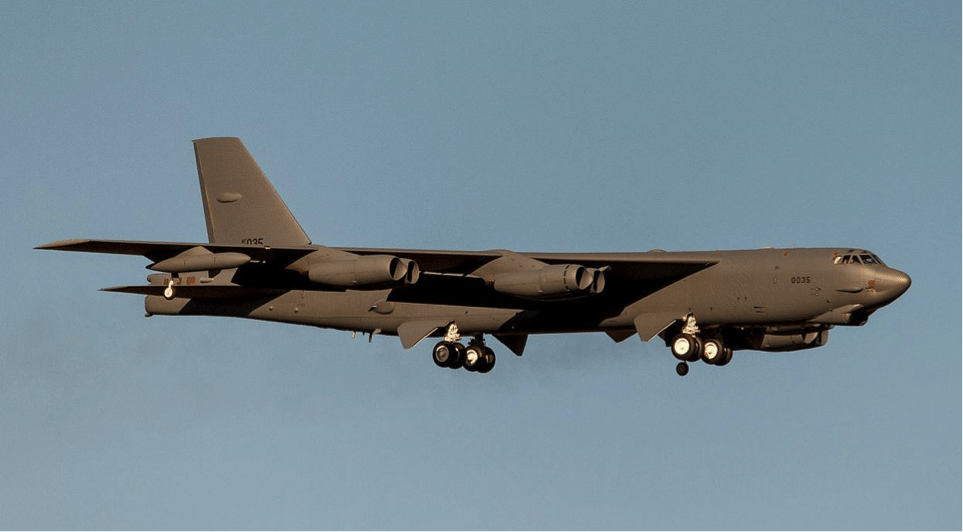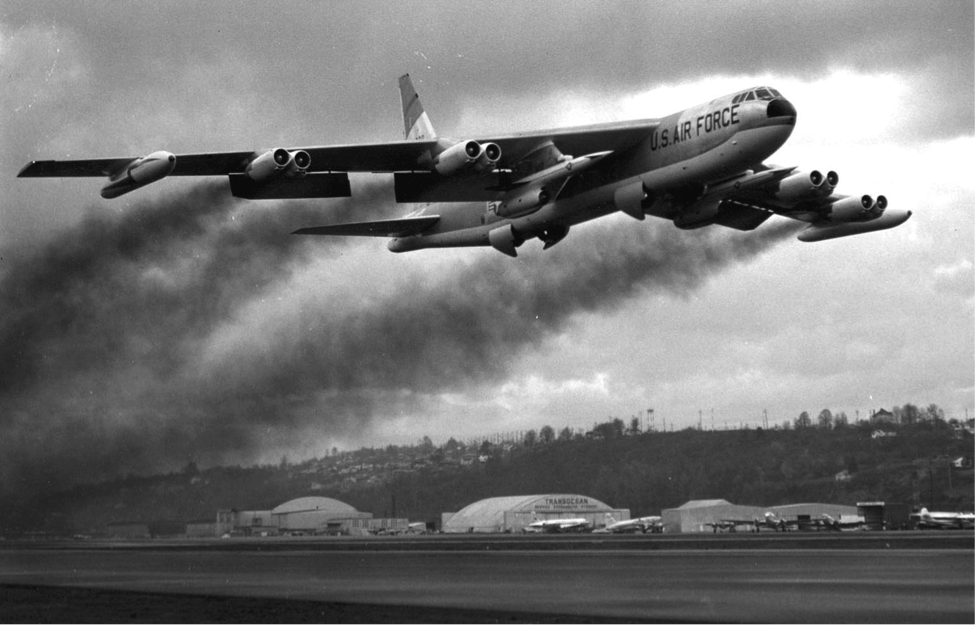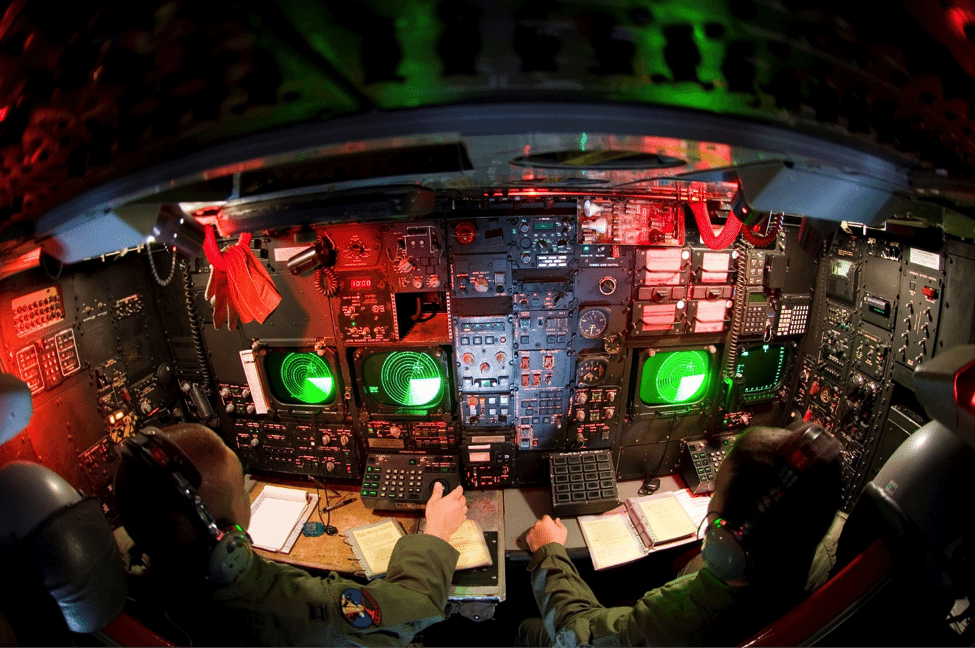Pods for Bombs
Continuing to improve the Stratofortress, GPS was added during the 1980s. Ability to employ the Northrup Grumman LITENING targeting pod was added in 2007. Carried on a dedicated pylon under the starboard wing, LITENING adds precision targeting of standoff weapons using laser guidance, high resolution FLIR, and high definition (HD) CCD camera. You’ve seen these pods on plenty of other aircraft including Grumman F-14D “Bombcats”, McDonnell Douglas (Boeing) FA/18 Hornets and AV-8B Harrier IIs, and General Dynamics F-16 Vipers.

Toting a Heavy Wallop
Like any bomber, the BUFF makes its living delivering ordnance. At its core it’s a bomber so it can carry up to 70,000 pounds (35 tons) of bombs, cruise missiles, standoff weapons, mines, and just about anything else that can be crammed into its cavernous bomb bay or hung from its wing pylons. The BUFF has been upgraded and adapted over its service life to carry the very latest weapons in the inventory. Originally equipped with defensive guns in the tail (four .50 caliber machine guns or a 20 millimeter Vulcan rotary cannon in the H model), all defensive tail weaponry has been removed from the B-52H tails still in service.

Old Smoky
The eight engines of the B-52 have been the subject of several upgrade and improvement programs over the years. None have been implemented yet. All versions of the BUFF through the G model were powered by one version or the other of the Pratt & Whitney J57 turbojet engine. The B-52H is powered by the Pratt & Whitney TF-33 turbofan engine, giving it improved range and total thrust available. A distinctive feature of the BUFF is the sooty black exhaust smoke that sometimes trails behind the aircraft caused by the use of water injection during takeoff. Water injection (actually a mix of water and alcohol) both increased thrust and cooled internal engine parts, but resulted in fuel being only partially burned- hence the smoky departure. Especially impressive during SAC minimal interval take offs (MITOs) in movies like A Gathering of Eagles (Universal 1963).

The Vietnam Slog
31 B-52s were lost during the Vietnam War (all causes). When B-52s went to war in Southeast Asia they were strategic bombers that had to be adapted to be used in a tactical situation. The Big Belly program added additional internal conventional bomb carrying capacity and Sun Bath modified the wing pylons to carry more bombs as well. Flying missions from Anderson AFB on Guam in the Pacific took a mind-numbing 10 to 12 hours to complete and required aerial refueling at least twice. Once B-52s began operating from U-Tapao in Thailand missions were shorter and required no refueling, but were just as dangerous. B-52 tail gunners shot down at least two North Vietnamese MiG-21 Fishbed interceptors. Another MiG-21 kill could not be credited to a particular BUFF but North Vietnamese records indicate a third MiG-21 shot down by B-52s.

Building the Even More Modern BUFF
As early-model B-52s reached the end of their structural service lives in the mid-1960s they were retired. By June 1966 there were no more B model BUFFs in service. By September of 1971 the C models had been put out to pasture. And so the story went. The B-52Es were retired by 1970. The majority of the F models were gone by 1973. The B-52Ds remained in service through the 60s and well into the 70s thanks to the Pacer Plank program, but during the early 1980s the Ds were retired too. The remaining G and H models were upgraded and their capabilities improved by adding the Boeing AGM-69 short range attack missile (SRAM) to the B-52’s arsenal, yet another major ECM refit, and the ability to carry the subsonic-cruise unarmed decoy (SCUD), the successor to the ADM-20 Quail.


[…] loves the BUFF. Boeing’s B-52H Stratofortress is still a front line weapons system more than sixty years after it entered United States Air Force […]
I was stationed at Blytheville Air Force Base in the 70’s. I also spent two years in Guam. I refueled the BUFF and KC-135’s in both places. Everything you said was right on. the only thing I may want to say is Anderson was(in the 70’s) called Anderson Air Base (drop the word Force), as it was the only permanent SAC base outside CONUS at that time. I watched them take off and land everyday, as my job had me on the flight line every day.
Bill: Your review is one of the best I ever read. The only thing I would add is that, in total, 744 B-52’s of all models were built. I was an Air Policeman with the 379th Air Police Squadron working flightline security with the 379th Bomb Wing (Heavy) at Wurtsmith AFB, Oscoda, MI from Dec 63 to Aug 67. I love the Buff, despite freezing by butt off many a cold Michigan night guarding them. I will travel out of my way to see one in a museum. One of my biggest thrills was seeing a full on MITO with 8 B-52’s and 5 KC-135’s during an ORI exercise one year. I was at the take-off end of the runway and they peeled off right over me. I will never forget the noise, smoke and pure power of freedom.